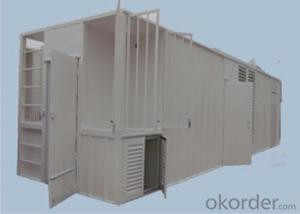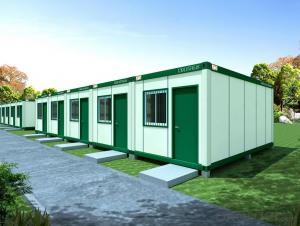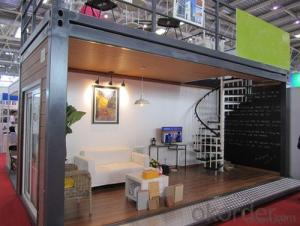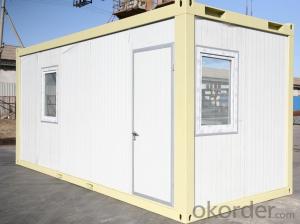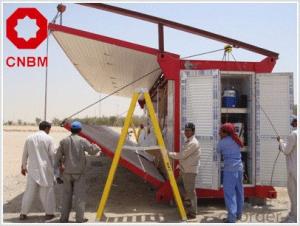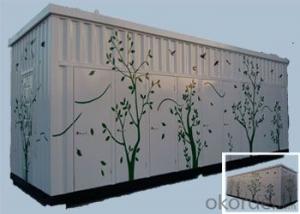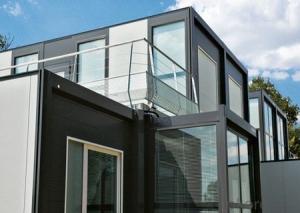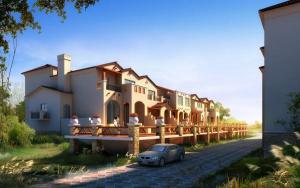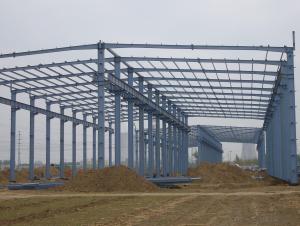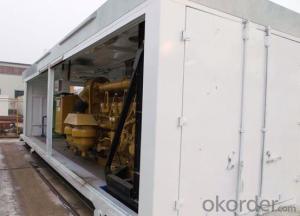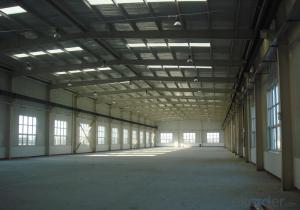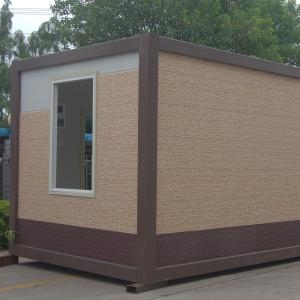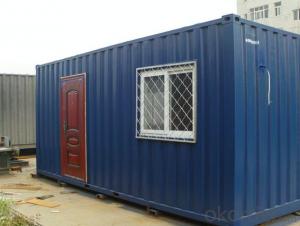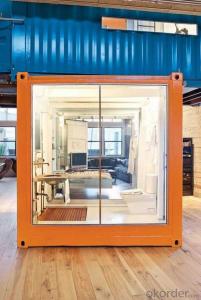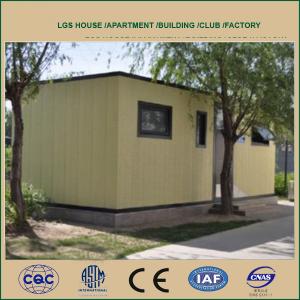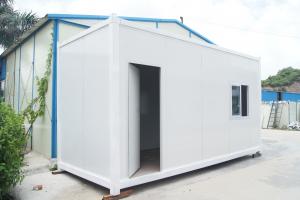Steel structure container house
- Loading Port:
- Tianjin
- Payment Terms:
- TT OR LC
- Min Order Qty:
- -
- Supply Capability:
- 20000 Set set/month
OKorder Service Pledge
Quality Product, Order Online Tracking, Timely Delivery
OKorder Financial Service
Credit Rating, Credit Services, Credit Purchasing
You Might Also Like
Steel structure container homes
20'FT Container house with bathroom facility
| component | long beam | 3mm galvanized |
| short beam | 2.5mm galvanized | |
| column | 3mm galvanized | |
| wall panel | 75mm EPS sandwich board | |
| roof panel | 75mm PU sandwich board | |
| secondary beam | Z-shaped galvanized steel iron | |
| roof insulation | 75mm polyurethane | |
| Floor panel | 18mm plywood panel+12mm laminated floor or 20mm cement-fiber +2mm PVC | |
| door | Steel Security door,740mmx1950mm | |
| window | PVC Sliding window with Rolling shutter,1100mmx800mm | |
| electronics, water supply and drainage | according to the local law | |
| furniture and appliance | Customized-made to your requirements |
- Q: Are container houses suitable for urban areas?
- Yes, container houses can be suitable for urban areas. They are a cost-effective and sustainable housing option that can help address the affordable housing crisis in cities. Container houses can be easily constructed, modified, and stacked, making them adaptable to urban environments with limited space. Additionally, their modern and modular design can contribute to creating aesthetically pleasing and innovative urban landscapes.
- Q: Can container houses be built with a garage or carport?
- Certainly, it is possible to construct container houses with a garage or carport. The modular characteristic of shipping containers enables simple customization and the incorporation of diverse structures. Numerous container house designs incorporate a garage or carport into the overall layout. Depending on the homeowner's preferences and space availability, these structures can either be connected to or separate from the main living area. Opting to build a garage or carport using shipping containers presents numerous advantages, including affordability, resilience, and eco-friendliness, thereby making it a favored choice among enthusiasts of container houses.
- Q: How about the comparison of container houses?
- nearly 1,000 yuan per square meter. Renovation costs in accordance with the simple, mid-range, luxury and other levels, ranging from 2500 to 5000 per square meter
- Q: Are container houses suitable for building on sloped terrain?
- Yes, container houses are suitable for building on sloped terrain. Container houses are known for their versatility and adaptability, making them an ideal choice for various landscapes, including sloped terrains. One of the main advantages of container houses is their ability to be easily stacked or placed on different levels, allowing for a seamless integration with the natural contours of the land. This means that container houses can be built on sloped terrains without the need for extensive modifications or costly foundation work. In addition, container houses can be customized to fit the specific needs of the sloped terrain. For instance, the containers can be strategically positioned to take advantage of the natural views and sunlight, creating a unique and sustainable living space. Furthermore, container houses can be designed with various access points, such as stairs or ramps, to ensure easy and safe movement on the sloped terrain. Another important factor to consider is the durability of container houses. Made from strong steel structures, container houses are designed to withstand extreme weather conditions, including on sloped terrains where erosion and shifting of the land may occur. This ensures that the house remains stable and secure over time, providing a long-lasting solution for building on sloped terrain. Overall, container houses offer a practical and efficient solution for building on sloped terrain. With their versatility, adaptability, and durability, container houses can create unique and sustainable living spaces that embrace the natural features of the land.
- Q: Can container houses be designed to have a home library?
- Yes, container houses can definitely be designed to have a home library. With careful planning and creative design, containers can be converted into functional and stylish spaces that accommodate bookshelves, reading nooks, and storage for a vast collection of books. The modular nature of container houses allows for customization, making it possible to incorporate a home library into the overall layout and design of the space.
- Q: Are container houses suitable for eco-tourism or sustainable resorts?
- Yes, container houses are suitable for eco-tourism or sustainable resorts. These houses are made from repurposed shipping containers, which reduces waste and promotes recycling. They can be designed to be energy-efficient, use sustainable materials, and incorporate renewable energy systems. Container houses also have a smaller carbon footprint compared to traditional construction methods. Thus, they align well with the principles of eco-tourism and sustainable development, making them a suitable choice for such establishments.
- Q: Can container houses be customized to fit individual preferences?
- Yes, container houses can be customized to fit individual preferences. Since container houses are built using shipping containers, they offer a flexible and versatile structure that can be modified and tailored to meet specific design and layout requirements. Various customization options are available, including floor plans, room divisions, window placements, exterior finishes, and interior decorations. This allows individuals to create personalized spaces that suit their unique preferences and needs.
- Q: What is the lifespan of a container house?
- The duration of a container house's existence can differ depending on various factors like the container's quality, maintenance practices, and environmental conditions it encounters. Typically, a container house that is well-constructed and properly maintained can endure for 25 to 50 years or possibly even longer. Container houses are usually constructed using shipping containers, which are composed of corten steel, a robust and corrosion-resistant material. This inherent strength enables them to withstand severe weather conditions, including powerful winds and heavy snow loads. Nevertheless, the lifespan of a container house can be influenced by issues such as rust, corrosion, and wear and tear. Consistent maintenance activities like cleaning, painting, and inspecting for signs of damage can significantly prolong the life of a container house. Moreover, the location and environmental conditions in which a container house is situated can also impact its lifespan. Extreme heat, humidity, and exposure to saltwater or other corrosive substances can hasten the deterioration of the container, potentially shortening its longevity. It is crucial to note that with appropriate care and maintenance, container houses can persist for several decades. In certain instances, containers can even be renovated and reinforced to further extend their lifespan. Ultimately, the durability of a container house is determined by the container's quality, maintenance efforts, and the environmental conditions it encounters.
- Q: Can container houses be stacked on top of each other?
- Yes, container houses can be stacked on top of each other. The strength and design of shipping containers allow them to be easily stacked and interconnected, making them suitable for creating multi-story container houses or even larger structures like apartment buildings or hotels.
- Q: Can container houses be easily transported to different locations?
- Indeed, container houses are meticulously crafted to ensure effortless relocation to diverse destinations. A key attribute of container houses lies in their mobility. These dwellings are ingeniously constructed using shipping containers, which are tailor-made for transportation objectives. Consequently, they can be seamlessly loaded onto trucks, ships, or trains to reach assorted locations. Moreover, container houses boast a lightweight and compact design, rendering them highly suitable for long-distance journeys. This convenience is further amplified by their easy dismantling and reassembly capabilities, enabling swift and efficient relocation. In summary, container houses provide a versatile and expedient housing solution that can be effortlessly transported to various destinations.
Send your message to us
Steel structure container house
- Loading Port:
- Tianjin
- Payment Terms:
- TT OR LC
- Min Order Qty:
- -
- Supply Capability:
- 20000 Set set/month
OKorder Service Pledge
Quality Product, Order Online Tracking, Timely Delivery
OKorder Financial Service
Credit Rating, Credit Services, Credit Purchasing
Similar products
Hot products
Hot Searches
Related keywords
